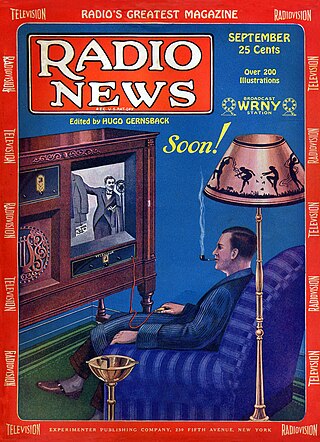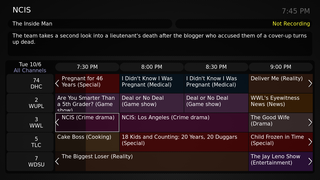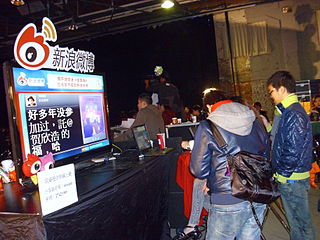Related Research Articles

TiVo is a digital video recorder (DVR) developed and marketed by Xperi and introduced in 1999. TiVo provides an on-screen guide of scheduled broadcast programming television programs, whose features include "OnePass" schedules which record every new episode of a series, and "WishList" searches which allow the user to find and record shows that match their interests by title, actor, director, category, or keyword. TiVo also provides a range of features when the TiVo DVR is connected to a home network, including film and TV show downloads, advanced search, online scheduling, and at one time, personal photo viewing and local music playback.

A television advertisement is a span of television programming produced and paid for by an organization. It conveys a message promoting, and aiming to market, a product, service or idea. Advertisers and marketers may refer to television commercials as TVCs.
A digital video recorder (DVR) is an electronic device that records video in a digital format to a disk drive, USB flash drive, SD memory card, SSD or other local or networked mass storage device. The term includes set-top boxes with direct to disk recording, portable media players and TV gateways with recording capability, and digital camcorders. Personal computers are often connected to video capture devices and used as DVRs; in such cases the application software used to record video is an integral part of the DVR. Many DVRs are classified as consumer electronic devices; such devices may alternatively be referred to as personal video recorders (PVRs), particularly in Canada. Similar small devices with built-in displays and SSD support may be used for professional film or video production, as these recorders often do not have the limitations that built-in recorders in cameras have, offering wider codec support, the removal of recording time limitations and higher bitrates.

A&E is an American basic cable network, the flagship television property of A&E Networks. The network was originally founded in 1984 as the Arts & Entertainment Network, initially focusing on fine arts, documentaries, dramas, and educational entertainment. Today, the network deals primarily in non-fiction programming, including reality docusoaps, true crime, documentaries, and miniseries.
Streaming television is the digital distribution of television content, such as TV shows, as streaming media delivered over the Internet. Streaming television stands in contrast to dedicated terrestrial television delivered by over-the-air aerial systems, cable television, and/or satellite television systems.
Broadcast programming is the practice of organizing or ordering (scheduling) of broadcast media shows, typically radio and television, in a daily, weekly, monthly, quarterly or season-long schedule.

Electronic programming guides (EPGs) and interactive programming guides (IPGs) are menu-based systems that provide users of television, radio and other media applications with continuously updated menus that display scheduling information for current and upcoming broadcast programming. Some guides also feature backward scrolling to promote their catch up content. They are commonly known as guides or TV guides.

Showcase is a Canadian English-language discretionary specialty channel owned by Corus Entertainment. Launched on January 1, 1995, the channel primarily airs scripted and dramatic television series.
Audience measurement measures how many people are in an audience, usually in relation to radio listenership and television viewership, but also in relation to newspaper and magazine readership and, increasingly, web traffic on websites. Sometimes, the term is used as pertaining to practices which help broadcasters and advertisers determine who is listening rather than just how many people are listening. In some parts of the world, the resulting relative numbers are referred to as audience share, while in other places the broader term market share is used. This broader meaning is also called audience research.
Television ratings in Australia are used to determine the size and composition of audiences across Australian broadcast and subscription television, primarily for the purpose of informing advertisers what programming is popular with the audience they are attempting to sell their product or service to.
Social television is the union of television and social media. Millions of people now share their TV experience with other viewers on social media such as Twitter and Facebook using smartphones and tablets. TV networks and rights holders are increasingly sharing video clips on social platforms to monetise engagement and drive tune-in.
In broadcasting, time shifting is the recording of programming to a storage medium to be viewed or listened to after the live broadcasting. Typically, this refers to TV programming but it can also refer to radio shows via podcasts.
Nielsen Media Research (NMR) is an American firm that measures media audiences, including television, radio, theatre, films, and newspapers. Headquartered in New York City, it is best known for the Nielsen ratings, an audience measurement system of television viewership that for years has been the deciding factor in canceling or renewing television shows by television networks. As of May 2012, it is part of Nielsen Holdings.
Advanced television is an array of features enabled by digital technology that significantly change analog television as it has come to be known during the 20th century. The term "advanced television" was first used at the MIT Media Lab in the early 1990s to explain why high-definition television was only an early step in the foreseeable enhancements to the medium. In 1996, David Weiss defined "advanced television" in his book, Issues in Advanced Television Technology to describe "an agglomeration of techniques, based largely on digital signal processing and transmission, that permits far more program material to be carried through channels than existing analog systems can manage." Today, advanced television can be characterized by four features: time shifting, addressability, interactivity and interoperability.
A second screen involves the use of a computing device to provide a different viewing experience for content on another device.

Social media and television have a number of connections and interrelationships that have led to the phenomenon of Social Television, which is an emerging communication digital technology that centers around real-time interactivity involving digital media displayed on television. The main idea behind Social Television is to make television consumption a more active content experience for audiences. In the 2010s, social media platforms and websites allow for television shows to be accessed online on a range of desktop and mobile computer devices, smartphones and smart TVs that are still evolving today in the 2020s. Alongside this, online users can use social media websites to share digital video clips or excerpts from TV shows with fellow fans or even share an entire show online. Many social media websites enable users to post online comments on the programs—both negative and positive—in a variety of ways. Viewers can actively participate while watching a TV program by posting comments online, and have their interactions viewed and responded to in real time by other viewers. Technologies such as smartphones, tablets, and laptop computers allow viewers to watch downloaded digital files of TV shows or "stream" digital files of TV shows on a range of devices, both in the home and while on the go. In the 2020s, many television producers and broadcasters encourage active social media participation by viewers by posting "hashtags" on the TV screen during shows; these hashtags enable viewers to post online comments about the show, which may either be read by other social media users, or even, in some cases, displayed on the screen during the show.

Hopper is a line of digital video recording (DVR) set-top boxes offered by the U.S. direct-broadcast satellite television provider Dish Network. First introduced at Consumer Electronics Show in January 2012, the Hopper was released in March 2012 as a component of the provider's whole-home DVR system, which networks the main Hopper unit with smaller "Joey" set-top boxes to form a client-server architecture.
Major annual or one-time televised mega-events can draw large viewership and significant interest from regional, national, and international advertisers. Advertisers strategically unveil major marketing campaigns in conjunction with televised mega-events and create memorable advertising content with high entertainment value. Some mega-event advertising, such as during the Super Bowl, even attracts a subset of viewers interested primarily in the advertising content. This type of advertisement is an increasingly common television phenomenon as televised mega-events become more popular and available globally.
References
- ↑ Villarreal, Yvonne (2014-05-12). "Upfronts 2014: Fox makes 'eventizing' a thing, the world (or a showrunner) reacts". Los Angeles Times . Retrieved 2014-06-13.
- ↑ Kjus, Yngvar. "Event Media". academia.edu. Retrieved 2015-08-31.
- ↑ Bauder, David (2014-05-19). "Networks' plea to viewers: Watch now!". Associated Press. Archived from the original on 2014-06-13. Retrieved 2014-06-13.
- ↑ Siegel, Robert; Poggi, Jeanine (2014-05-29). "For TV Advertisers, a Hunt for Live Audiences" (Interview). NPR . Retrieved 2014-06-13.
- ↑ Garvin, Glenn (2012-01-24). "TV execs crave viewers who watch two screens". Miami Herald . Archived from the original on 2012-02-04.
- ↑ Albertazzi, Daniele; Cobley, Paul, eds. (September 13, 2013). The Media: An Introduction (3rd ed.). Routledge. ISBN 9781317865216.
- ↑ Slattery, Laura (2014-03-13). "Event television goes extraterrestrial in race for ratings". Irish Times . Retrieved 2014-06-13.
- 1 2 3 Brown, Les (1992). "Event television" . Les Brown's Encyclopedia of Television (3rd ed.). Gale Research. p. 178. ISBN 0-8103-8871-5. LCCN 91-48157 – via The Internet Archive.
- 1 2 "Quatermass creator dies, aged 84". BBC News Online. 2006-11-01. Archived from the original on 2014-06-13. Retrieved 2014-06-13.
- ↑ Most-Watched Television Finales: Top 20 Of All Time - GIANT FREAKIN ROBOT